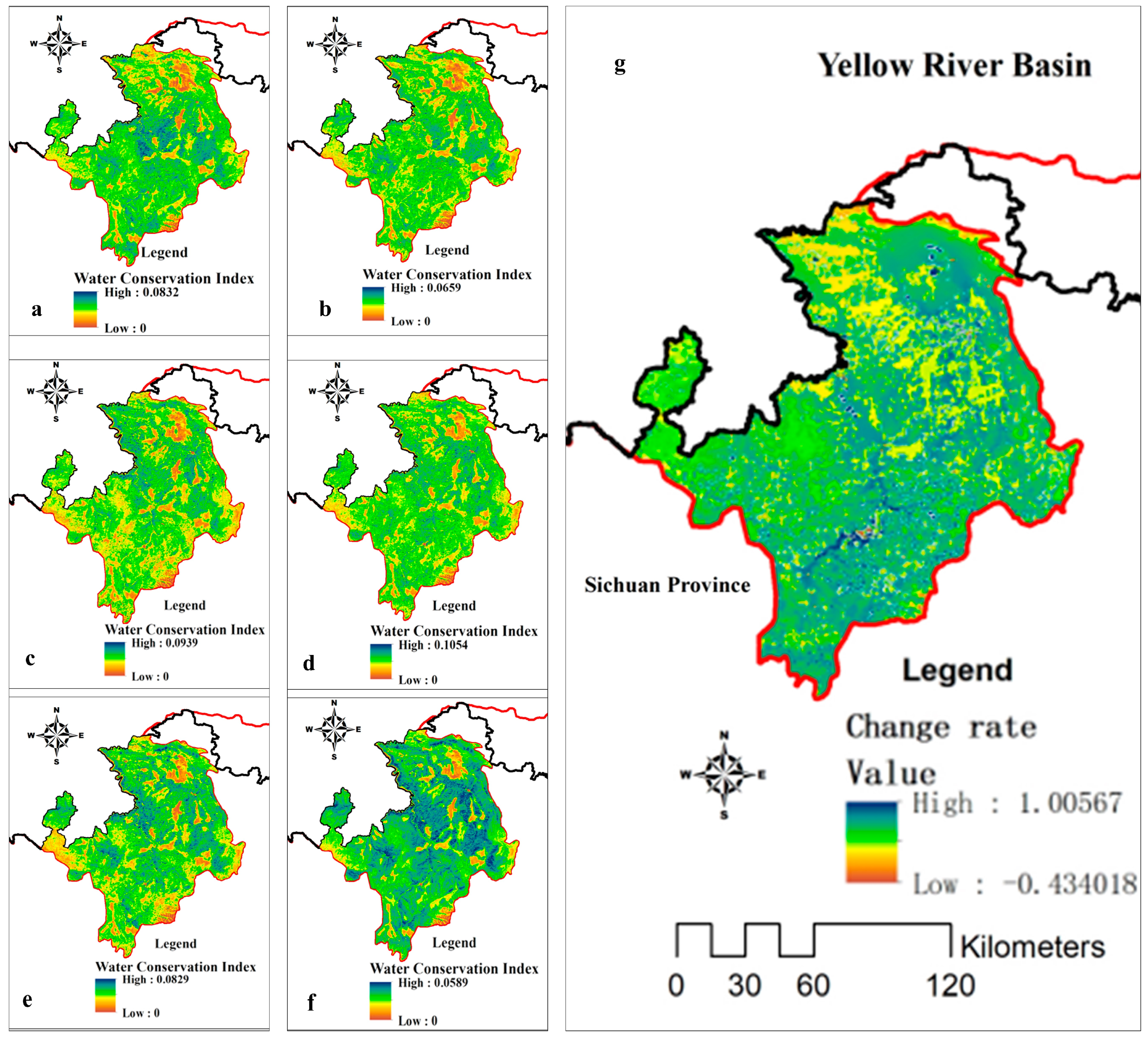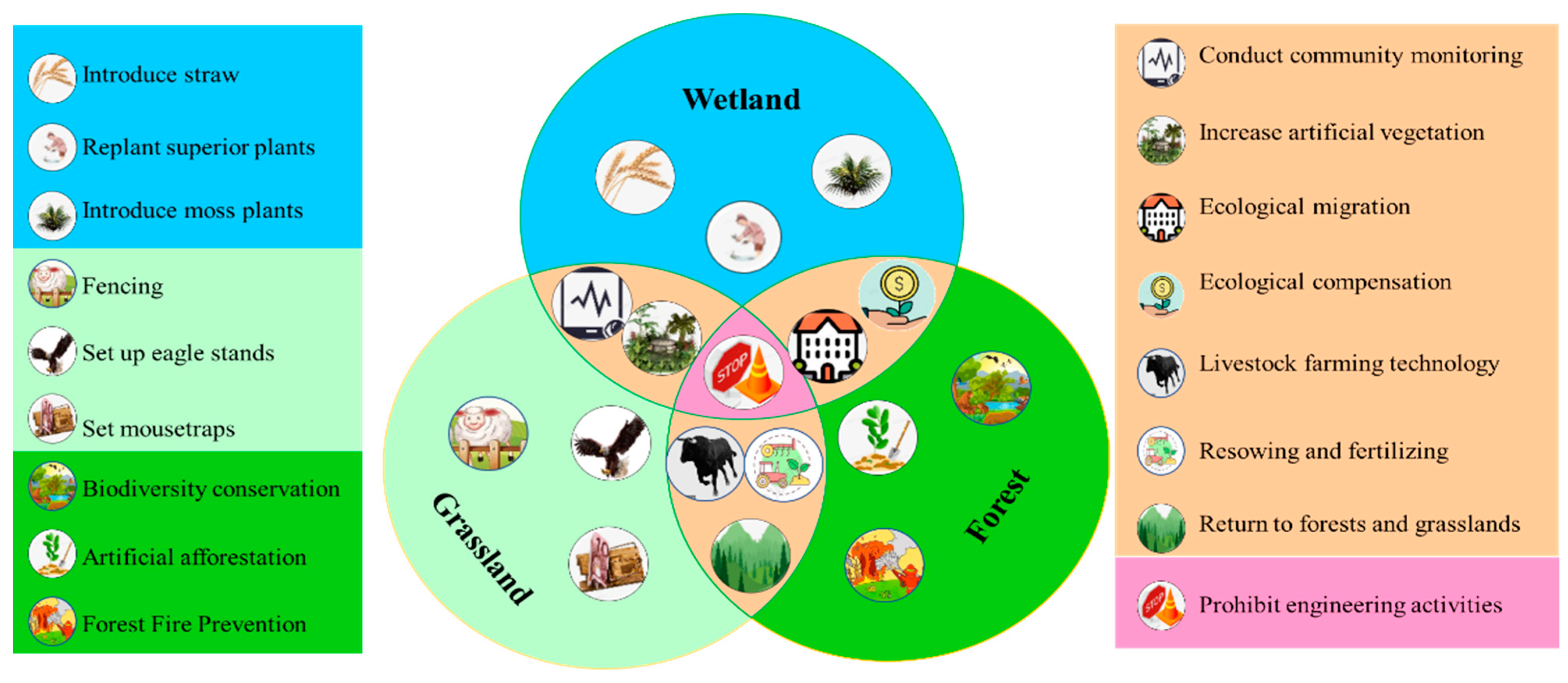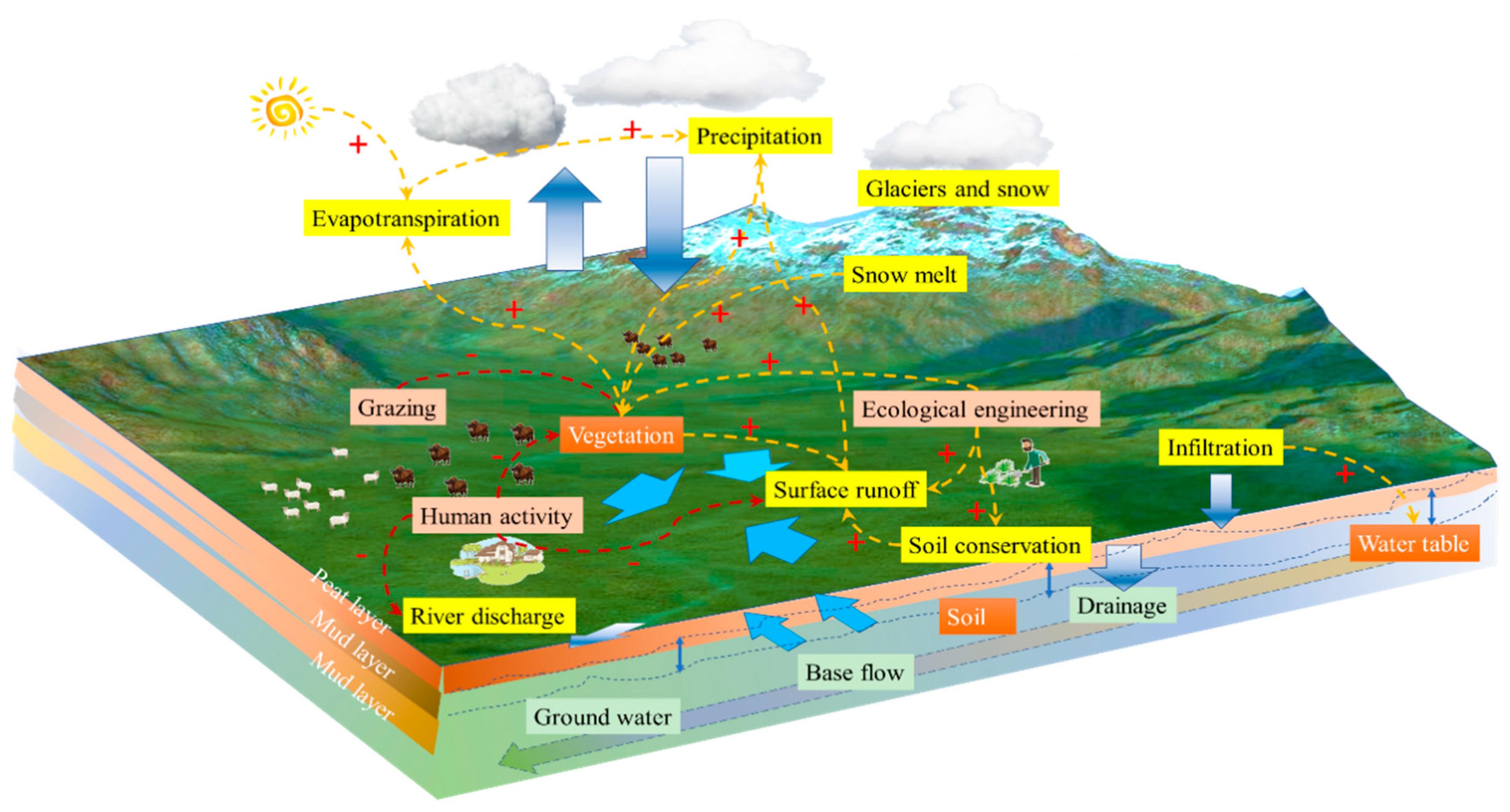Multi-Scale Ecological Restoration Strategies to Enhance Water Conservation in Ruoergai on the Qinghai–Tibet Plateau
Abstract
1. Introduction
2. Results
2.1. Degradation of Grasslands and Wetlands
2.2. Trends in Water Conservation in the Ruoerge Region
2.3. Multi-Scale Ecological Restoration Strategies
3. Discussion
3.1. Mechanisms of Water Conservation in Alpine Wetlands
3.2. Temporal and Spatial Evolution of Human Impacts on Water Conservation in the Ruoergai Wetlands
3.3. Ecological–Economic–Social Dimensions of Water Conservation Capacity Enhancement
4. Materials and Methods
4.1. Study Area
4.2. Data Sources and Methods
4.2.1. Data Sources
4.2.2. InVEST Model
4.2.3. Trend Analysis
4.2.4. Field Survey and Ecological Restoration Project Research
5. Conclusions
Author Contributions
Funding
Data Availability Statement
Conflicts of Interest
References
- Zhang, C.S.; Xie, G.D.; Liu, C.L.; Fan, N.; Wang, X.K. Assessment of the superiority and inferiority of water conservation functions in Chinese ecosystems based on the water conservation reference system. Acta Ecol. Sin. 2022, 42, 1–11, (In Chinese with English Abstract). [Google Scholar]
- Jacque, H.; Mozafari, B.; Dereli, R.K.; Cotterill, S. Implications of water conservation measures on urban water cycle: A review. Sustain. Prod. Consum. 2024, 50, 571–586. [Google Scholar] [CrossRef]
- Lutz, A.F.; Immerzeel, W.W.; Shrestha, A.B.; Bierkens, M.F.P. Consistent increase in High Asia’s runoff due to increasing glacier melt and precipitation. Nat. Clim. Change 2014, 4, 587–592. [Google Scholar] [CrossRef]
- Altobelli, F.; Vargas, R.; Corti, G.; Dazzi, C.; Montanarella, L.; Monteleone, A.; Caon, L.; Piazza, M.G.; Calzolari, C.; Munafò, M.; et al. Improving soil and water conservation and ecosystem services by sustainable soil management practices: From a global to an Italian soil partnership. Ital. J. Agron. 2020, 15, 1765. [Google Scholar] [CrossRef]
- Nie, Y.; Gong, B.; Li, Z. Spatiotemporal changes in water conservation capacity of the Qinghai-Tibet Plateau. Front. Earth Sci. China 2010, 17, 373–377, (In Chinese with English Abstract). [Google Scholar]
- Gong, S.H.; Xiao, Y.; Zheng, H.; Xiao, Y.; Ouyang, Z.Y. Spatial characteristics and influencing factors of water conservation in Chinese ecosystems. Acta Ecol. Sin. 2017, 37, 2455–2462, (In Chinese with English Abstract). [Google Scholar]
- Xiong, Y.Q.; Wu, P.F.; Zhang, H.Z.; Cui, L.W.; He, X.J. Soil water conservation function during the degradation process of the Ruoergai wetland. Acta Ecol. Sin. 2011, 31, 5780–5788, (In Chinese with English Abstract). [Google Scholar]
- Liu, J.H.; Zheng, X.; Fan, J.M.; Zhao, L.L. Evaluation of the value of water retention service in the middle and upper reaches of Hunhe River based on SWAT model. Chin. J. Appl. Ecol. 2021, 32, 3905–3912, (In Chinese with English Abstract). [Google Scholar]
- Tyagi, M.; Singh, H.; Thakur, D.A.; Mohanty, M.P. Compound risks of floods and droughts over multi-hazard catchments: Revealing association through hydrodynamic-cum-statistical modelling and novel bivariate risk classifier. Sci. Total Environ. 2024, 957, 177689. [Google Scholar] [CrossRef]
- Yuan, Y.; Zhang, L.; Cui, L. Spatiotemporal characteristics of water conservation function in the Ruoergai Plateau ecosystem. Ecol. J. 2022, 39, 2713–2723, (In Chinese with English Abstract). [Google Scholar]
- Almulhim, A.I.; Abubakar, I.R. Exploring household water conservation behaviors in Saudi Arabia: A structural equation modeling approach. J. Open Innov. Technol. Mark. Complex. 2025, 11, 100486. [Google Scholar] [CrossRef]
- Valladares-Castellanos, M.; Crespo, R.d.J.; Xu, Y.J.; Douthat, T.H. A framework for validating watershed ecosystem service models in the United States using long-term water quality data: Applications with the InVEST Nutrient Delivery (NDR) model in Puerto Rico. Sci. Total Environ. 2024, 949, 175111. [Google Scholar] [CrossRef]
- Tian, Q.; Li, Z.; Chen, X. Analysis of spatiotemporal patterns and driving factors of water conservation in wetland ecosystems based on the InVEST model. Acta Ecol. Sin. 2017, 37, 1614–1624, (In Chinese with English Abstract). [Google Scholar]
- Immerzeel, W.W.; Lutz, A.F.; Andrade, M.; Bahl, A.; Biemans, H.; Bolch, T.; Hyde, S.; Brumby, S.; Davies, B.J.; Elmore, A.C.; et al. Importance and vulnerability of the world’s water towers. Nature 2020, 577, 364–369. [Google Scholar] [CrossRef]
- Ma, K.; Zhang, Y.; Tang, S.; Liu, J. Spatial distribution of soil organic carbon in the Zoige alpine wetland, Northeastern Qinghai–Tibet Plateau. Catena 2016, 144, 102–108. [Google Scholar] [CrossRef]
- Jiang, M.; Li, H.; Zhang, W.; Liu, J.; Zhang, Q. Effects of climate change and grazing on the soil organic carbon stock of alpine wetlands on the Qinghai-Tibet Plateau from 2000 to 2018. Catena 2024, 238, 107870. [Google Scholar] [CrossRef]
- Thomas, E.K.; Huang, Y.; Clemens, S.C.; Colman, S.M.; Morrill, C.; Wegener, P.; Zhao, J. Changes in dominant moisture sources and the consequences for hydroclimate on the northeastern Tibetan Plateau during the past 32 kyr. Quat. Sci. Rev. 2016, 131, 157–167. [Google Scholar] [CrossRef]
- Qiu, M.; Liu, Y.; Tian, F.; Wang, S.; Fu, B. Marsh decrease was much faster than the water increase among the Yellow River source wetlands during 1986–2022. Sci. Total Environ. 2024, 947, 174377. [Google Scholar] [CrossRef]
- Li, H.; Wang, Y.; Chen, W.; Li, H.; Tian, Y.; Chen, R. Evaluation of ecosystem services in Ruoergai national park, China. Sustainability 2024, 16, 3241. [Google Scholar] [CrossRef]
- Tal-maon, M.; Broitman, D.; Portman, M.E.; Housh, M. Combining a hydrological model with ecological planning for optimal placement of water-sensitive solutions. J. Hydrol. 2024, 628, 130457. [Google Scholar] [CrossRef]
- Wang, S.; Fu, B.; Piao, S.; Lü, Y.H.; Ciais, P.; Feng, X.M.; Wang, Y.D. Reduced sediment transport in the Yellow River due to anthropogenic changes. Nat. Geosci. 2016, 9, 38–41. [Google Scholar] [CrossRef]
- Piczak, M.L.; Theis, S.; Portiss, R.; Ruppert, J.L.W.; Midwood, J.D.; Cooke, S.J. Evaluating the efficacy of ecological restoration of fish habitat in coastal waters of Lake Ontario. Sci. Total Environ. 2024, 953, 176088. [Google Scholar] [CrossRef]
- Bian, J.; Li, A.; Deng, W. Estimation and analysis of net primary Productivity of Ruoergai wetland in China for the recent 10 years based on remote sensing. Procedia Environ. Sci. 2010, 2, 288–301. [Google Scholar] [CrossRef]
- Li, Z.W.; Wang, Z.Y.; Brierley, G.; Nicoll, T.; Pan, B.Z.; Li, Y.F. Shrinkage of the Ruoergai swamp and changes to landscape connectivity, Qinghai-Tibet Plateau. Catena 2015, 126, 155–163. [Google Scholar] [CrossRef]
- Yin, Y.; Wu, S.; Zhao, D.; Dai, E.F. Impact of climate change on water conservation in the source area of the Yellow River over the past 30 years. Geogr. Res. 2016, 35, 49–57, (In Chinese with English Abstract). [Google Scholar]
- Yao, T.D.; Thompson, L.; Yang, W.; Yu, W.S.; Gao, Y.; Guo, X.J.; Yang, X.X.; Duan, K.Q.; Zhao, H.B.; Xu, B.Q.; et al. Different glacier status with atmospheric circulations in Qinghai-Tibet Plateau and surroundings. Nat. Clim. Change 2012, 2, 663–667. [Google Scholar] [CrossRef]
- Gao, C.; Huang, C.; Wang, J.B.; Li, Z. Modelling dynamic hydrological connectivity in the Zoigê area (China) based on multi-temporal surface water observation. Remote Sens. 2022, 14, 145. [Google Scholar] [CrossRef]
- Masaeli, Y.; Ahmadi, A. Assessing the suitability of groundwater resources based on farmers’ predicted intentions and human–water feedbacks. J. Hydrol. 2024, 644, 132057. [Google Scholar] [CrossRef]
- Liu, H.; Duan, C.; Li, J. Degradation of the grasslands in the Ruoergai Plateau and its remote sensing monitoring. J. Grassl. Sci. 2006, 15, 1–9, (In Chinese with English Abstract). [Google Scholar]
- Yu, D.W.; Liu, Y.; Xie, D.J.; Mu, C.L.; Sun, Z.Y.; Zhou, M.J.; Rao, J.P.; Suolang, D.; Xiong, Y.Q.; Chen, J.S. Effects of driving factors on water supply function under different basins and spatial scale in Zoige alpine wetland, China. Ecol. Indic. 2024, 158, 111403. [Google Scholar] [CrossRef]
- Xiao, D.; Tian, B.; Tian, K. Landscape patterns and their changes in Sichuan Ruoergai wetland National Nature Reserve. Acta Ecol. Sin. 2010, 30, 27–32. [Google Scholar] [CrossRef]
- Guo, Y.Y.; Zeng, J.; Wu, W.X.; Hu, S.Q.; Liu, G.X.; Wu, L.S.; Bryant, C.R. Spatial and temporal changes in vegetation in the Ruoergai Region, China. Forests 2021, 12, 76. [Google Scholar] [CrossRef]
- Zhang, X.H.; Liu, H.Y.; Baker, C.; Graham, S. Restoration approaches used for degraded peatlands in Ruoergai (Zoige), Qinghai-Tibet Plateau, China, for sustainable land management. Ecol. Eng. 2012, 38, 86–92. [Google Scholar] [CrossRef]
- Guo, S.L.; Deng, X.; Ran, J.X.; Ding, X.Y. Spatial and temporal patterns of ecological connectivity in the ethnic areas, Sichuan Province, China. Int. J. Environ. Res. Public Health 2022, 19, 12941. [Google Scholar] [CrossRef]
- Zhang, X.; Lu, X. Multiple criteria evaluation of ecosystem services for the Ruoergai Plateau Marshes in Southwest China. Ecol. Econ. 2010, 69, 1463–1470. [Google Scholar] [CrossRef]
- Wei, J.X.; Hu, A.; Gan, X.Y.; Zhao, X.D.; Huang, Y. Spatial and temporal characteristics of ecosystem service trade-off and synergy relationships in the western Sichuan Plateau, China. Forests 2022, 13, 1845. [Google Scholar] [CrossRef]
- Sun, Z.Y.; Wang, Y.Q.; Lin, J.R.; Gao, P.C. Land system simulation of Ruoergai Plateau by integrating MaxEnt and boltzmann entropy into CLUMondo. Land 2023, 12, 1450. [Google Scholar] [CrossRef]
- Chang, A.X.; Wu, T.; Li, B.W.; Jiao, D.Z.; Wang, Y.S.; He, D.; Jiang, Z.H.; Fan, Z.Y. Distribution pattern of species richness of endemic genera in mountainous areas of southwest China and its influencing factors. Sustainability 2024, 16, 3750. [Google Scholar] [CrossRef]
- Agudelo, C.A.R.; Bustos, S.L.H.; Moreno, C.A.P. Modeling interactions among multiple ecosystem services. A critical review. Ecol. Model. 2020, 429, 109103. [Google Scholar] [CrossRef]
- Shrestha, S.; Yao, T.; Adhikari, T.R. Analysis of rainfall trends of two complex mountain river basins on the southern slopes of the Central Himalayas. Atmos. Res. 2019, 215, 99–115. [Google Scholar] [CrossRef]









| Name | Data Sources | Resolution/m |
|---|---|---|
| Land use type | Data Centre for Resource and Environmental Sciences, Chinese Academy of Sciences (https://www.resdc.cn/) | 30 |
| Evaporation | National Earth System Science Data Centre (http://www.geodata.cn) | 30 |
| River data | Resource Environmental Science and Data Centre (https://www.resdc.cn) | —— |
| Slope direction | Geospatial data cloud (http://www.gscloud.cn/) | 30 |
| Elevation | Geospatial data cloud (http://www.gscloud.cn/) | 30 |
| Soil data (soil depth, soil saturated hydraulic conductivity, soil sand content, soil clay content) | World Soil Database (HWSD) (Harmonised World Soil Database version 1.1, http://data.tpdc.ac.cn, accessed on 31 March 2025) | 1000 |
| Vegetation cover | Cloud platform for resource and environmental data (http://www.Resdc.cn/doi/doi.aspx?doiid=49, accessed on 31 March 2025) | 30 |
Disclaimer/Publisher’s Note: The statements, opinions and data contained in all publications are solely those of the individual author(s) and contributor(s) and not of MDPI and/or the editor(s). MDPI and/or the editor(s) disclaim responsibility for any injury to people or property resulting from any ideas, methods, instructions or products referred to in the content. |
© 2025 by the authors. Licensee MDPI, Basel, Switzerland. This article is an open access article distributed under the terms and conditions of the Creative Commons Attribution (CC BY) license (https://creativecommons.org/licenses/by/4.0/).
Share and Cite
Liu, S.; Dong, Y.; Sun, Y.; Wang, Q. Multi-Scale Ecological Restoration Strategies to Enhance Water Conservation in Ruoergai on the Qinghai–Tibet Plateau. Plants 2025, 14, 1085. https://doi.org/10.3390/plants14071085
Liu S, Dong Y, Sun Y, Wang Q. Multi-Scale Ecological Restoration Strategies to Enhance Water Conservation in Ruoergai on the Qinghai–Tibet Plateau. Plants. 2025; 14(7):1085. https://doi.org/10.3390/plants14071085
Chicago/Turabian StyleLiu, Shiliang, Yuhong Dong, Yongxiu Sun, and Qingbo Wang. 2025. "Multi-Scale Ecological Restoration Strategies to Enhance Water Conservation in Ruoergai on the Qinghai–Tibet Plateau" Plants 14, no. 7: 1085. https://doi.org/10.3390/plants14071085
APA StyleLiu, S., Dong, Y., Sun, Y., & Wang, Q. (2025). Multi-Scale Ecological Restoration Strategies to Enhance Water Conservation in Ruoergai on the Qinghai–Tibet Plateau. Plants, 14(7), 1085. https://doi.org/10.3390/plants14071085








